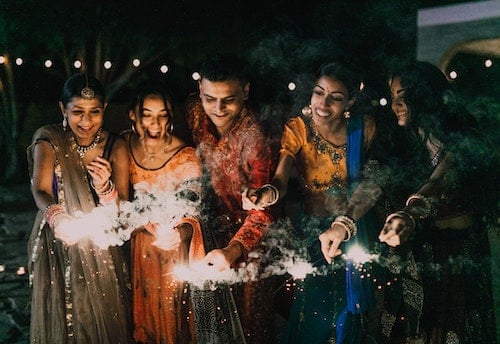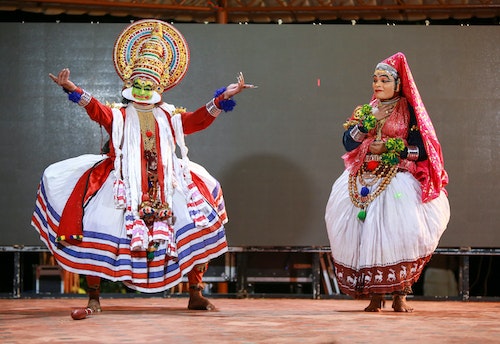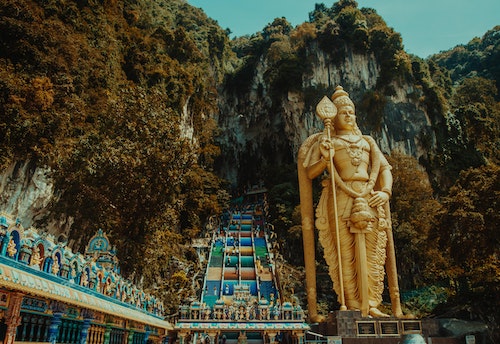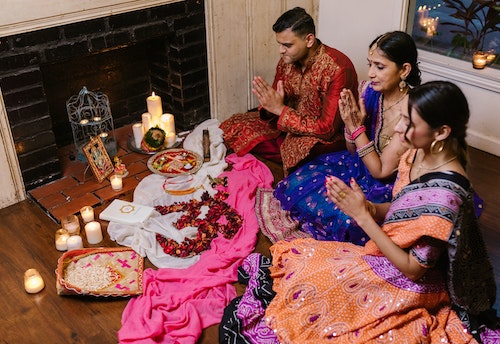Unique Indian Traditions to Know Before Traveling
When most people think about India, the first thing that comes to mind is its many customs and traditions, from their striking religious imagery to their colorful clothes and carefully arranged meals. There are so many of them, in fact, that it can be difficult to know where to start. But one thing is for sure: learning about Indian traditions before traveling will make for a much more enriching experience than visiting India without knowing anything about it.
Table of Contents
→Sign Up Now: Free Trial Hindi Lesson With a Native Teacher!←
While it would be impossible to cover everything that makes India unique in only one blog, here is a list of essential Indian traditions that we think everyone should know before booking their tickets.
Festivals and Celebrations
1. Holi – The Festival of Colours
Holi is probably one of the best-known Indian traditions abroad, and it’s easy to see why. This festival, which takes place in late February or early March, is all about celebrating springtime and the triumph of good over evil. And what better way to do that than by pelting your friends and family with colorful powders and water?
Of course, there is more to Holi than just throwing colors around. According to legend, Holi celebrates the victory of Prince Prahlad, who was a devotee of Lord Vishnu, over his evil aunt Holika. Holika had tricked Prahlad into sitting on a pyre with her, believing that her evil powers would protect her from the flames while he would be burned alive. However, the opposite happened and Holika was burned to death while Prahlad emerged unscathed.
Since then, Hindus have been celebrating Holi by burning bonfires (symbolic of Holika’s pyre) and throwing colored powders and water at each other. The colors represent the joy and happiness that comes with springtime, while the bonfires are meant to ward off evil spirits.
The most vivid celebrations of Holi take place in North India, in the Golden Triangle of Delhi, Agra, and Jaipur,
2. Diwali – The Festival of Lights
Diwali, which falls on the new moon in either October or November, depending on the Hindu lunar calendar, is another well-known Indian festival, and it’s often compared to Christmas in the West. That’s because both holidays are all about spending time with family, exchanging gifts, and eating lots of delicious food.

But while Christmas celebrates the birth of Jesus Christ, Diwali commemorates the return of Lord Rama to his kingdom after defeating the demon king Ravana. According to the Hindu epic Ramayana, Rama had been exiled from his kingdom for 14 years and during that time he made allies with the monkey god Hanuman and defeated Ravana in a great battle.
Diwali, one of the most joyous of Indian traditions, is typically celebrated by lighting lamps and candles all around the house, as well as setting off fireworks. The light is meant to represent the triumph of good over evil, while the fireworks are symbolic of the celebration that takes place when Rama returns home. This year, it will be celebrated from October 20th to 25th all across the country.
3. Ganesh Chaturthi – The Birth of Lord Ganesha
Ganesh Chaturthi is a Hindu festival that celebrates the birth of Lord Ganesha, the elephant-headed god of wisdom and prosperity. The festival takes place for 10 days in August or September and it’s one of the most popular Indian traditions among tourists. Though you can join this festival all across in India, the most impressive celebrations can be found in the states of Maharashtra, Goa, Madhya Pradesh, and Telangana.
On the first day of Ganesh Chaturthi, Hindus bring home an idol of Ganesh and worship him for 10 days. They offer him food and sweets, and on the last day, they take the idol to a nearby body of water and immerse it in order to symbolically release him back into the cosmos.
Ganesh Chaturthi is a very important festival for Hindus because it celebrates one of their most popular and widely revered deities. Lord Ganesha is a god that symbolizes knowledge and well-being, and he is often invoked at the beginning of important undertakings as a way to ensure a successful outcome, which gives him a very special place among Indian traditions and beliefs.
4. Onam – The Harvest Festival
Onam is a Hindu festival that celebrates the harvest season in Kerala, a southern state in India. The festival takes place in August or September and lasts for 10 days.
During Onam, Hindus dress up in traditional clothes and celebrate with feasts, music, and dance. One of the most popular Onam traditions is the snake boat race, which sees teams of rowers racing each other in long boats shaped like snakes.

The festival is also a time for Hindus to pay tribute to their ancestors. On the first day of Onam, Hindus offer prayers and flowers at their local temples as a way of honoring their ancestors.
Though Onam is a Hindu festival, anyone can participate in the celebrations. You don’t have to be Hindu to enjoy the feasts, music, and dance that take place during this time.
The importance of food in India
When it comes to food and meals, Indians are quite particular about their customs and etiquette, so there are a few things that you should keep in mind if you ever find yourself dining in India.
First of all, according to Indian traditions it’s considered impolite to start eating before the host has had a chance to serve everyone. However, it is absolutely normal (customary, in fact) to eat with your hands, so don’t be surprised if you see people using their fingers to scoop up food from their plates.
If you’re dining with Hindus, you should also know that they consider the cow to be a sacred animal. As such, they do not eat beef. If you’re not Hindu, you don’t have to follow this rule, but it’s something to be aware of.
What are the most traditional foods in India?
When it comes to traditional Indian food, there are a few dishes that come to mind. One of the most popular is curry, which is a stew made with meat or vegetables and a variety of spices.
Another popular dish is tandoori chicken, which is chicken that has been marinated in yogurt and spices, then grilled in a tandoor, or clay oven.
Other traditional Indian dishes include dal, a type of lentil soup; naan, a type of flatbread; and biryani, a rice dish made with meat or vegetables.
Indian food is typically quite spicy, so if you’re not a fan of spice, be sure to ask for your food to be made “mild” when you order.
The Religions of India
India is a country with a rich religious history, and the religions practiced there vary greatly.
There are three main religions in India: Hinduism, Islam, and Sikhism. Knowing the basic differences between them is a huge part of understanding Indian traditions and beliefs.
Hinduism is the dominant religion in India. It is polytheistic and has no single founder or set of scriptures. Hindus believe in a cyclical nature to the universe, and that death is not the end of life but rather the beginning of a new cycle.

Islam is the second-largest religion in India. It is monotheistic, and its followers believe in one God, called Allah. Muslims believe that the Quran is the word of God, and that Muhammad was His prophet.
Sikhism is the third-largest religion in India. It was founded in the 1500s by Guru Nanak. Sikhs believe in one God, and that all people are equal in His eyes. They also believe in social justice and helping those who are less fortunate.
There are also a number of other minority religions practiced in India, such as Buddhism, Jainism, and to a lesser extent, Christianity. Because the latter is a minor religion in the country, not many Indian traditions are shaped after it.
The caste system in India
The caste system is a social hierarchy that has been in place in India for centuries. It is a system of social stratification that divides people into different groups, or castes, based on their occupation.
There are four main castes in India: the Brahmins, the Kshatriyas, the Vaishyas, and the Shudras. The Brahmins are the highest caste, and they are priests or scholars. The Kshatriyas are warriors or rulers. The Vaishyas are farmers or traders. And the Shudras are laborers or servants.
There is also a fifth caste, known as the Dalits, which consists of people who are considered to be outside of the caste system.
The caste system is a controversial topic in India, and there have been many efforts to abolish it. However, it remains a significant part of Indian traditions.
The importance of family in India
Family is extremely important for Indian traditions and customs. The concept of a joint family, where several generations of a family live together under one roof, is still very common in India.
In a joint family, the oldest male member is the head of the household. He makes all of the major decisions for the family, and the other members of the family are expected to obey his authority.
The extended family is also involved in important life events, such as births, marriages, and deaths. For example, it is common for a bride to move into the home of her husband’s parents after marriage.
The concept of family is so important in India that it is not uncommon for people to choose their profession based on what will benefit their family instead of what they are passionate about.

Indian traditions are rich, complex, and mind-opening. From the delicious food to the ancient caste system, there are many things that make India unique. These are just a few of the many Indian traditions and customs that you will find when you visit this fascinating country.
→Sign Up Now: Free Trial Hindi Lesson With a Native Teacher!←
Would you like to study Hindi with a native teacher and be able to understand and participate in these traditions yourself? You can start learning Hindi now with one of our tailored courses taught by native tutors. Just send us a quick inquiry and we’ll get back to you in no time.


